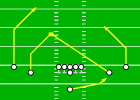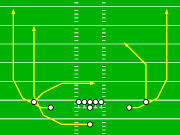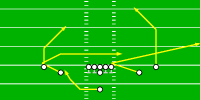Overview
As its name says, 4 Wide lines up 4 wide receivers across the line of scrimmage, with flankers to the inside. Like with the Slingshot formation, this is designed to stretch the defensive backfield. Unlike Slingshot, 4 Wide places the quarterback under center to get the ball in his hands as quickly as possible, facilitating quick throws. In addition, although 4 Wide is best used as a passing formation, it also features fast developing, straight ahead running plays to provide good balance.
                    
                    
                    
                    
                    
                    
|
Because of its speed based design, the running back usually runs a fifth pattern on short passing plays, with the intent of the QB releasing the ball before a blitz has time to get to him. On the less frequently used medium and long range plays, the running back may stay in to provide additional protection. Plays develop very quickly, so the most important read the QB makes happen before the ball is snapped. Unlike most passing plays, the receiver is not open when he is in open space, but rather when he is moving towards a space that is open (or will be open in about a half-second). These plays may seem ineffective to novices because of the timing and precision needed, but with practice you'll be able to carve up defenses like a surgeon.
The fast development of passing plays has a big impact on read progressions. Most reads have to scan an area of the field in one glance, taking in both receivers to one side simultaneously, then the other side, and finally the running back. Often, matchup advantages can be spotted before the play starts, allowing the QB to lock in on a receiver for an immediate throw. Additionally, it is hard to make reads on 4 to 5 routes in under two seconds, so it is often necessary to pick out just two or three that look good before snapping the ball, and not worry about the others unless the play breaks down.
The given wide receiver assignments emphasize the flankers over the split ends due to the quick throws used, though different plays may favor each flanker differently. You need to determine which plays you like best, and assign your top two receivers to the flanker positions accordingly. The split ends are assigned to best balance the receivers on each side of the formation.
Plays

Quick Slants
Quick Slants works as a great change-up to slow developing pass plays. Though it uses no extra blockers, it works great against blitzes because of its lightning quick execution.

Undertow
The little brother of Undercuts, this play creates nightmarish matchup problems for cornerbacks, allowing quick passes for medium yardage with potential to break open for big gains.

Snapback
A nice little passing play that is especially effective against man coverage. The two flankers start sharp left, then turn back to the right, forcing defenders to chase from behind.
Contact Arkaein with any comments or questions regarding the Monstrous Madden Playbook.